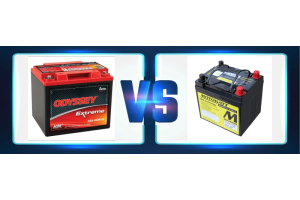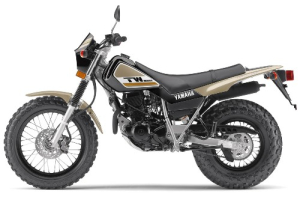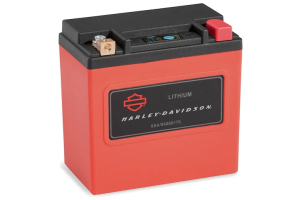BiPolar Batteries: Is Manic the Term we should Be Using?
I was reading about an innovative company known as Advanced Battery Concepts (ABC for short) out of Clare, MI. They have developed a BiPolar battery technology that promises to propel the lead acid battery industry into the limelight once again. For this age old industry, thought to be in its twilight years, fighting against competing technologies, such as lithium-ion and NIMH Cobalt, this truly is remarkable. But what makes this technology so extraordinary? And perhaps more importantly, what is a bipolar battery and why should we care?
A Short Historical Foundation
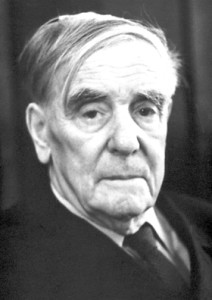 I will attempt to keep my terminology and definitions ultra-simple and relate examples of them to names and brands you may recognize. To begin, let’s start with the inventor.
I will attempt to keep my terminology and definitions ultra-simple and relate examples of them to names and brands you may recognize. To begin, let’s start with the inventor.
The concept of a bipolar battery has been around for nearly 100 years! Pyotr Kapitsa, who won the Nobel Prize in Physics in 1978, first introduced the theory behind bipolar batteries back in 1924. This Russian born scientist is famous for many discoveries including super-fluidity which is the phenomenon allowing liquid helium, at very low temperatures, to flow without resistance.
Currently, there are two primary forms of the sealed lead acid battery. The prismatic battery and the spiral cell battery. The prismatic battery (perhaps referred to as monopolar by some) is by far the most widely adopted and used by companies such as East Penn (DEKA) Manufacturing, MotoBatt, Yuasa and Trojan for example. The spiral bound battery is marketed by Johnson Controls under the Optima brand name.
The spiral cell, despite having great vibration resistance, is limited by non-usable voided space (picture six circles in two rows of three. The space between the circles and edge of the battery is wasted). This limitation of active material means you cannot harness any power gains from that region of the battery. Prismatic batteries have an ants-go-marching-one-by-one effect, where electrons have to start at one end of the gauntlet and follow the entire path to the other end. (I threw in the word gauntlet to make the process seem more villainous, it’s not). This continuous path through the hanging grids increases internal resistance which produces excess heat. Again, placing limitations on power and energy density.
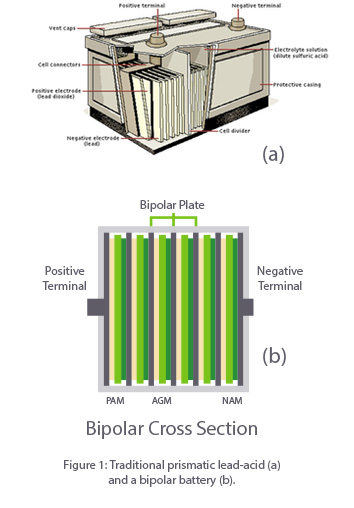 In contrast, a bipolar design allows for a more direct route. Electrons can pass straight through without first needing to ‘explore’ the far expanses of the battery. The advantages of bipolar batteries have long been known. They should provide uniform current density, increased active material utilization, higher energy density, higher power density and simpler construction. However, cost and technical constraints have limited the practical applications despite the efforts of countless organizations.
In contrast, a bipolar design allows for a more direct route. Electrons can pass straight through without first needing to ‘explore’ the far expanses of the battery. The advantages of bipolar batteries have long been known. They should provide uniform current density, increased active material utilization, higher energy density, higher power density and simpler construction. However, cost and technical constraints have limited the practical applications despite the efforts of countless organizations.
But that has all changed!
The BiPolar Battery Advantage
ABC has successfully designed a bipolar, lead-acid battery and developed and implemented a commercially viable manufacturing process. Yes! This is Reason to become manic over Bipolar Batteries. As they share and license this technology, expect to hear announcements from mainline manufacturers over the coming months and years. New ‘green and clean’ claims will be made as there is less waste and more power generated from the same size footprint as standard lead acid prismatic batteries. I imagine motive, telecom and large group size batteries for renewable energy will be the first to implement the technology. Thereafter I would say the industrial, recreational vehicle and marine market will introduce it, followed by the automotive and perhaps power sport market. Cost should stay competitive with the premium lead acid market and will not be nearly as expensive as comparable lithium products.
Let's look at Energy Denisty a little closer to help create that sense of mania towards this technology. I'm told the theoretical energy density for lead acid electro-chemistry is 167Wh/kg. Today’s best lead acid batteries achieve about 38Wh/kg. To say it another way they are only 23% efficient (rounding up). This new bipolar technology can create batteries ranging from 50Wh/kg to 63wh/kg. That is a 30% to 65% increase when contrasted with comparable batteries on the market!
Here are some of the potential benefits:
- Higher Energy Density - 37% Efficient Compard to 23% Efficient or Less
- Smaller Physical Size - Can Be Made Up To 30% Smaller
- Charge Faster - Reduce Charge Times By 50%
- Cycle Longer - 2x to 6x Improvements
- Extreme Vibration Resistance - Fewer Internal Components to Fail Means Up To 20x Better
- Lower System Installation Cost - Can Build A Higher Voltage Monoblock
- Lower Pack Heat Generation - Creates Longer Battery Cycle Life and Reduced Cost of Ownership
- Novel Shapes - Can Follow Shapes That Are Not Uniform; Triangles, Circles, Long Rectangles Are All Possible.
- Batteries Can Be Used As Structural Components - Example: Assemble Seat Post Directly to the Battery for an eBike
- Can Be Designed For Energy Or Power Or Both - BCI Group 24 Battery Delivers Over 1,200 CCA (2X the CCA of Conventional), With an Additional 20%+ of Energy.

